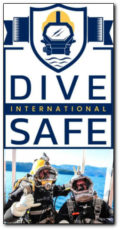Mine Countermeasures Deep Divers: Not a Drill
By CADC Admin ~ July 31st, 2019. Filed under: EDUCATION, JOBS, Latest Diving News, Uncategorized.
“This is not a drill! This is not a drill!” The ship’s intercom echoed the chilling words loudly throughout the vessel as we were alerted that the emergency message about to follow was not a drill. It was real.
Instinctively, I quickly grabbed my camera and, rushing on deck, observed through the camera’s viewfinder what I believed could be an impending death. It was not what I anticipated doing on a calm, bright, and sunny day off the coast of Portugal.
I was on a two-week photo assignment to document operations of the NATO Naval Special Forces, including our own elite Canadian Forces Clearance Divers from both of our fleet dive units. They were part of a multi-national naval special forces deep diving training exercise. The tasks included diving to 80 metres using rebreathers from only a rubber boat! Our large dive support vessel was anchored several-hundred meters away from the dive sites.
In the distance, an inflatable boat was incoming at a high speed toward our dive support vessel with a stricken diver onboard in a desperate attempt to reach our onboard decompression chambers. He had been recovered unconscious from the ocean floor at a depth of 78 metres and was brought to the surface by his buddy—both of them had omitted all decompression stops in the scramble to get to the safety of the surface. However, omitted decompression from such a depth could be fatal. This was no drill! This was real! This was serious!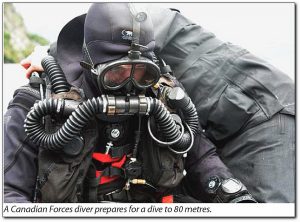
Tough call in the line of duty
Through my telephoto lens directed at the speeding boat, I could see a fully dressed diver lying on the floor of the boat being tended to by topside support, who were attempting to perform CPR and mouth-to-mouth resuscitation. My task on the exercise was to photo document everything on the exercise—good or bad. We had discussed this early on in the exercise; if anything happened, I was not to stop filming. I felt nauseated and torn between doing what I was supposed to be doing and respectfully choosing not to fire the shutter, as I fully realized I may be witnessing and documenting the death of one of our own. My conflicted mind raced, “Do your job. It is why you are here.”
The boat got to the support vessel and the diver was hoisted quickly up the ladder. Hand-over-hand, the stretcher holding his motionless body was passed from anxious waiting hands, as he was whisked quickly into the waiting decompression chamber. The rescue diver followed him into the second chamber, and the long decompression table for omitted decompression began. Luckily, both survived. The photos I took of the accident were immediately turned over to the military to be used for accident investigation. The rescue diver received a medal for his bravery.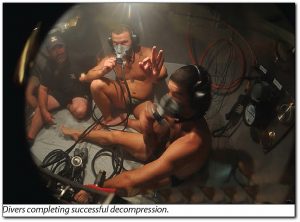
Trained to act fast in dire situations
The deep diving exercises are held in different parts of the world as a training exercise with real-life scenarios that Mine Counter Measures (MCM) personnel encounter. The aim and objective is to exercise and improve the effectiveness of integrated Deep Diving MCM teams in a broad range of rebreather tasks. MCM teams are the underwater equivalent to the land-specific Explosive Ordinance Disposal / Improvised Explosive Device Disposal (EOD / IEDD) teams. MCM personnel are, in fact, specialized EOD technicians trained in underwater mine clearance operations. It is not unusual to find an MCM team involved in land-based explosive clearing operations far away from the sea.
Because of the depth / duration capability of the equipment they use and its highly portable nature—in addition to military MCM operations—the military also deploys such equipment and teams in support of civilian missions that include deep salvage and recovery. This has included body recovery from marine disasters and deep salvage of civilian aircraft lost at sea. They are well-prepared to react to fast deployment in remote places where deep diving is required.
Military units integrate at times with civilian police and security agencies in the protection of our harbours and ports. Many specialized civilian police and public service dive units have similar EOD / IEDD training skills, which are used both on the surface and underwater.
When success or failure can mean life or death
From my perspective as a photographer—having spent over 20 years integrating with this group—what I have observed and photographed of them plying their trade over the years is nothing but extraordinary. There is a common denominator—or trait— I’ve seen in them all.
In their world of EOD / IEDD both underwater and on the surface, whether it is military or in the civil commercial, what they do has only two outcomes: either you are successful, or you aren’t. There is no half-measure. It can be life or death. It is real.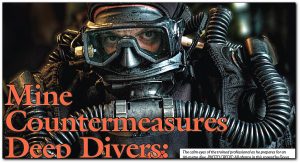
That common denominator I see on the other side of my lens is in the eyes; they are the eyes of a trained professional, and those eyes reflect an inner calm. They know what they’re doing. They’ve been through it before. It’s a trait hard-wired into a well-trained professional diver.
When life announces that gut-wrenching situation with, “No Drill! No Drill! No Drill!” they truly are trained and ready to deal with it. You can see it in the eyes.
Reprint from CADC Magazine – Summer 2019 – By Doug Elsey, Executive Director, Canadian Association of Diving Contractors / Documentary Photographer. (Download the complete magazine below)2019 CADC MAG SPRING SUMMER FINAL
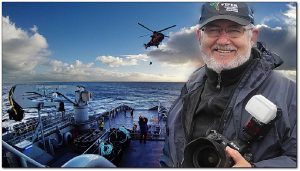 Doug Elsey is executive director of the Canadian Association of Diving Contractors. He is also a professional documentary photographer specializing in photo documentation in high-risk environments. He has documented over 20 NATO naval special forces EOD / MCM exercises around the globe, both below and above the waterline in bad weather, scorching heat, sub-zero Arctic cold, high seas and miserable places. “What they do is not for everyone. They are a special breed. I am in total awe of this courageous group and truly honoured to have the opportunity to share their world. They have my deepest and highest respect.” Learn more at www.DougElsey.com.
Doug Elsey is executive director of the Canadian Association of Diving Contractors. He is also a professional documentary photographer specializing in photo documentation in high-risk environments. He has documented over 20 NATO naval special forces EOD / MCM exercises around the globe, both below and above the waterline in bad weather, scorching heat, sub-zero Arctic cold, high seas and miserable places. “What they do is not for everyone. They are a special breed. I am in total awe of this courageous group and truly honoured to have the opportunity to share their world. They have my deepest and highest respect.” Learn more at www.DougElsey.com.





